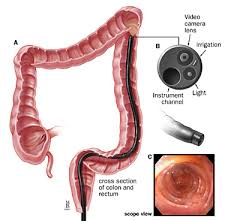
What is flexible sigmoidoscopy?
Flexible sigmoidoscopy is a procedure in which a trained medical professional uses a flexible, narrow tube with a light and tiny camera on one end, called a sigmoidoscope or scope, to look inside your rectum and lower colon, also called the sigmoid colon and descending colon. Flexible sigmoidoscopy can show irritated or swollen tissue, ulcers, polyps, and cancer.
Why do doctors use flexible sigmoidoscopy?
A flexible sigmoidoscopy can help a doctor find the cause of unexplained symptoms, such as
-
bleeding from your anus
-
changes in your bowel activity such as diarrhea
-
pain in your abdomen
-
unexplained weight loss
Doctors also use flexible sigmoidoscopy as a screening tool for colon polyps and colon and rectal cancer. Screening may find diseases at an early stage, when a doctor has a better chance of curing the disease.
Screening for colon and rectal cancer:
Your doctor will recommend screening for colon and rectal cancer at age 50 if you don’t have health problems or other factors that make you more likely to develop colon cancer.
Factors that make you more likely to develop colorectal cancer include
-
someone in your family has had polyps or cancer of the colon or rectum
-
a personal history of inflammatory bowel disease, such as ulcerative colitis or Crohn's disease
-
other factors, such as if you weigh too much or smoke cigarettes
If you are more likely to develop colorectal cancer, your doctor may recommend screening at a younger age, and you may need to be tested more often.
If you are older than age 75, talk with your doctor about whether you should be screened. For more information, read the current colorectal cancer screening guidelines from the U.S. Preventive Services Task Force (USPSTF).
Most doctors recommend colonoscopy to screen for colon cancer because colonoscopy shows the entire colon and can remove colon polyps. However, preparing for and performing a flexible sigmoidoscopy may take less time and you may not need anesthesia . Health care providers may combine flexible sigmoidoscopy with other tests.
If your doctor finds abnormal tissue or one or more polyps during a flexible sigmoidoscopy, you should have a colonoscopy to examine the rest of your colon.
Government health insurance plans, such as Medicare, and private health insurance plans sometimes change whether and how often they pay for cancer screening tests. Check with your insurance plan to find out how often your insurance will cover a screening flexible sigmoidoscopy.
Visit the National Cancer Institute’s website to learn more about colon and rectal cancer.
How do I prepare for a flexible sigmoidoscopy?
To prepare for a flexible sigmoidoscopy, you will need to talk with your doctor, change your diet, and clean out your bowel.
Talk with your doctor
You should talk with your doctor about any medical conditions you have and all prescribed and over-the-counter medicines, vitamins, and supplements you take, including:
-
arthritis medicines
-
aspirin or medicines that contain aspirin
-
blood thinners
-
diabetes medicines
-
nonsteroidal anti-inflammatory drugs, such as ibuprofen or naproxen
-
vitamins that contain iron or iron supplements
How do doctors perform a flexible sigmoidoscopy?
A trained medical professional performs a flexible sigmoidoscopy during an office visit or at a hospital or an outpatient center. You typically do not need sedatives or anesthesia, and the procedure takes about 10 minutes.
For the procedure, you’ll be asked to lie on a table while the doctor inserts a sigmoidoscope into your anus and slowly guides it through your rectum and into your sigmoid colon. The scope pumps air into your large intestine to give the doctor a better view. The camera sends a video image of your intestinal lining to a monitor, allowing the doctor to examine the tissues lining your sigmoid colon and rectum. The doctor may ask you to move several times on the table to adjust the scope for better viewing. Once the scope has reached your transverse colon, the doctor slowly withdraws it and examines the lining of your sigmoid colon again.
During the procedure, your doctor may remove polyps and send them to a lab for testing. Colon polyps are common in adults and are harmless in most cases. However, most colon cancer begins as a polyp, so removing polyps early is an effective way to prevent cancer.
If your doctor finds abnormal tissue, he or she may perform a biopsy. You won’t feel the biopsy.
If your doctor found polyps or other abnormal tissue during a flexible sigmoidoscopy, your doctor may suggest you return for a colonoscopy.
What should I expect after a flexible sigmoidoscopy?
After a flexible sigmoidoscopy, you can expect the following:
You may have cramping in your abdomen or bloating during the first hour after the procedure.
You can resume regular activities right away after the procedure.
You can return to a normal diet.
A health care professional will give you written instructions on how to take care of yourself after the procedure and will review them with you. You should follow all instructions.
If the doctor removed polyps or performed a biopsy, you may have light bleeding from your anus. This bleeding is normal. Some results from a flexible sigmoidoscopy are available right after the procedure, and your doctor will share these results with you. A pathologist will examine the biopsy tissue. Biopsy results take a few days or longer to come back.
What are the risks of a flexible sigmoidoscopy?
The risks of a flexible sigmoidoscopy include
bleeding,
perforation of the colon
severe pain in your abdomen
death, although this risk is rare
Bleeding and perforation are the most common complications from flexible sigmoidoscopy. Most cases of bleeding occur in patients who have polyps removed. The doctor can treat bleeding that occurs during the flexible sigmoidoscopy right away. However, you may have delayed bleeding up to 2 weeks after the procedure. The doctor diagnoses and treats delayed bleeding with a colonoscopy or repeat flexible sigmoidoscopy. The doctor may need to treat perforation with surgery.


